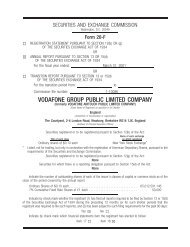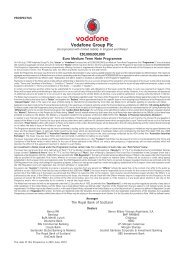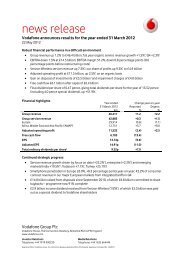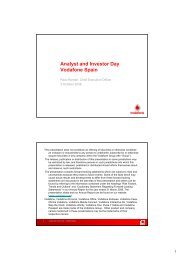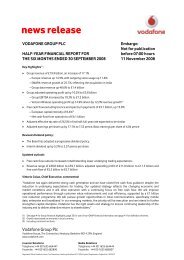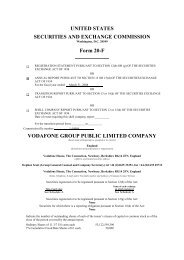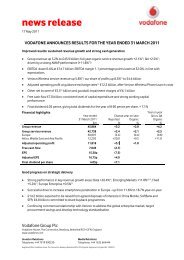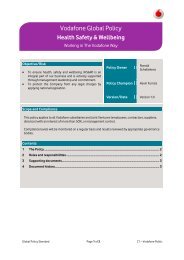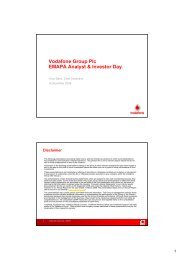Create successful ePaper yourself
Turn your PDF publications into a flip-book with our unique Google optimized e-Paper software.
Notes to <strong>the</strong> Company Financial Statements<br />
1. Basis of preparation<br />
The separate financial statements of <strong>the</strong> Company are drawn up in accordance<br />
with <strong>the</strong> Companies Act 1985 and UK generally accepted accounting principles<br />
(“UK GAAP”).<br />
The preparation of Company Financial Statements in conformity with generally<br />
accepted accounting principles requires management to make estimates and<br />
assumptions that affect <strong>the</strong> <strong>report</strong>ed amounts of assets and liabilities and<br />
disclosure of contingent assets and liabilities at <strong>the</strong> date of <strong>the</strong> Company Financial<br />
Statements and <strong>the</strong> <strong>report</strong>ed amounts of revenue and expenses during <strong>the</strong><br />
<strong>report</strong>ing period. Actual results could differ from those estimates. The estimates<br />
and underlying assumptions are reviewed on an ongoing basis. Revisions to<br />
accounting estimates are recognised in <strong>the</strong> period in which <strong>the</strong> estimate is revised<br />
if <strong>the</strong> revision affects only that period or in <strong>the</strong> period of <strong>the</strong> revision and future<br />
periods if <strong>the</strong> revision affects both current and future periods.<br />
As permitted by Section 230 of <strong>the</strong> Companies Act 1985, <strong>the</strong> profit and loss<br />
account of <strong>the</strong> Company is not presented in this Annual Report. These separate<br />
financial statements are not intended to give a true and fair view of <strong>the</strong> profit or<br />
loss or cash flows of <strong>the</strong> Company. The Company has not published its individual<br />
cash flow statement as its liquidity, solvency and financial adaptability are<br />
dependent on <strong>the</strong> Group ra<strong>the</strong>r than its own cash flows.<br />
The Company has taken advantage of <strong>the</strong> exemption contained in FRS 8 “Related<br />
party disclosures” and has not <strong>report</strong>ed transactions with fellow Group undertakings.<br />
The Company has taken advantage of <strong>the</strong> exemption contained in FRS 29<br />
“Financial Instruments: Disclosures” and has not produced any disclosures<br />
required by that standard, as disclosures that comply with FRS 29 are available<br />
in <strong>the</strong> <strong>Vodafone</strong> Group Plc Annual Report for <strong>the</strong> year ended 31 March 2008.<br />
2. Significant accounting policies<br />
The Company’s significant accounting policies are described below.<br />
Accounting convention<br />
The Company Financial Statements are prepared under <strong>the</strong> historical cost<br />
convention and in accordance with applicable accounting standards of <strong>the</strong> UK<br />
Accounting Standards Board and pronouncements of <strong>the</strong> Urgent Issues Task Force.<br />
Investments<br />
Shares in Group undertakings are stated at cost less any provision for impairment.<br />
The Company assesses investments for impairment whenever events or<br />
changes in circumstances indicate that <strong>the</strong> carrying value of an investment may<br />
not be recoverable. If any such indication of impairment exists, <strong>the</strong> Company<br />
makes an estimate of <strong>the</strong> recoverable amount. If <strong>the</strong> recoverable amount of <strong>the</strong><br />
cash-generating unit is less than <strong>the</strong> value of <strong>the</strong> investment, <strong>the</strong> investment<br />
is considered to be impaired and is written down to its recoverable amount.<br />
An impairment loss is recognised immediately in <strong>the</strong> profit and loss account.<br />
For available-for-sale investments, gains and losses arising from changes in fair<br />
value are recognised directly in equity, until <strong>the</strong> investment is disposed of or is<br />
determined to be impaired, at which time <strong>the</strong> cumulative gain or loss previously<br />
recognised in equity, determined using <strong>the</strong> weighted average cost method,<br />
is included in <strong>the</strong> net profit or loss for <strong>the</strong> period.<br />
Foreign currencies<br />
In preparing <strong>the</strong> Company Financial Statements, transactions in currencies o<strong>the</strong>r<br />
than <strong>the</strong> Company’s functional currency are recorded at <strong>the</strong> rates of exchange<br />
prevailing on <strong>the</strong> dates of <strong>the</strong> transactions. At each balance sheet date, monetary<br />
items denominated in foreign currencies are retranslated at <strong>the</strong> rates prevailing<br />
on <strong>the</strong> balance sheet date. Non-monetary items carried at fair value that are<br />
denominated in foreign currencies are retranslated at <strong>the</strong> rate prevailing on <strong>the</strong><br />
date when fair value was determined. Non-monetary items that are measured<br />
in terms of historical cost in a foreign currency are not retranslated.<br />
Exchange differences arising on <strong>the</strong> settlement of monetary items, and on <strong>the</strong><br />
retranslation of monetary items, are included in <strong>the</strong> profit and loss account for <strong>the</strong><br />
period. Exchange differences arising on <strong>the</strong> retranslation of non-monetary items<br />
carried at fair value are included in <strong>the</strong> profit and loss account for <strong>the</strong> period.<br />
Borrowing costs<br />
All borrowing costs are recognised in <strong>the</strong> profit and loss account in <strong>the</strong> period<br />
in which <strong>the</strong>y are incurred.<br />
Taxation<br />
Current tax, including UK corporation tax and foreign tax, is provided at amounts<br />
expected to be paid (or recovered) using <strong>the</strong> tax rates and laws that have been<br />
enacted or substantively enacted by <strong>the</strong> balance sheet date.<br />
Deferred tax is provided in full on timing differences that exist at <strong>the</strong> balance<br />
sheet date and that result in an obligation to pay more tax, or a right to pay less<br />
tax in <strong>the</strong> future. The deferred tax is measured at <strong>the</strong> rate expected to apply in<br />
<strong>the</strong> periods in which <strong>the</strong> timing differences are expected to reverse, based on<br />
<strong>the</strong> tax rates and laws that are enacted or substantively enacted at <strong>the</strong> balance<br />
sheet date. Timing differences arise from <strong>the</strong> inclusion of items of income and<br />
expenditure in taxation computations in periods different from those in which<br />
<strong>the</strong>y are included in <strong>the</strong> Company Financial Statements. Deferred tax assets are<br />
recognised to <strong>the</strong> extent that it is regarded as more likely than not that <strong>the</strong>y will<br />
be recovered. Deferred tax assets and liabilities are not discounted.<br />
Financial instruments<br />
Financial assets and financial liabilities in respect of financial instruments are<br />
recognised on <strong>the</strong> Company Balance Sheet when <strong>the</strong> Company becomes a party<br />
to <strong>the</strong> contractual provisions of <strong>the</strong> instrument.<br />
Financial liabilities and equity instruments<br />
Financial liabilities and equity instruments issued by <strong>the</strong> Company are classified<br />
according to <strong>the</strong> substance of <strong>the</strong> contractual arrangements entered into and <strong>the</strong><br />
definitions of a financial liability and an equity instrument. An equity instrument is<br />
any contract that evidences a residual interest in <strong>the</strong> assets of <strong>the</strong> Company after<br />
deducting all of its liabilities and includes no obligation to deliver cash or o<strong>the</strong>r<br />
financial assets. The accounting policies adopted for specific financial liabilities<br />
and equity instruments are set out below.<br />
Capital market and bank borrowings<br />
Interest-bearing loans and overdrafts are initially measured at fair value (which is<br />
equal to cost at inception) and are subsequently measured at amortised cost<br />
using <strong>the</strong> effective interest rate method, except where <strong>the</strong>y are identified as a<br />
hedged item in a fair value hedge. Any difference between <strong>the</strong> proceeds net of<br />
transaction costs and <strong>the</strong> settlement or redemption of borrowings is recognised<br />
over <strong>the</strong> term of <strong>the</strong> borrowing.<br />
Equity instruments<br />
Equity instruments issued by <strong>the</strong> Company are recorded at <strong>the</strong> proceeds received,<br />
net of direct issue costs.<br />
Derivative financial instruments and hedge accounting<br />
The Company’s activities expose it to <strong>the</strong> financial risks of changes in foreign<br />
exchange rates and interest rates.<br />
The use of financial derivatives is governed by <strong>the</strong> Group’s policies approved by<br />
<strong>the</strong> Board of directors, which provide written principles on <strong>the</strong> use of financial<br />
derivatives consistent with <strong>the</strong> Group’s risk management strategy.<br />
Derivative financial instruments are initially measured at fair value on <strong>the</strong> contract<br />
date and are subsequently re-measured to fair value at each <strong>report</strong>ing date.<br />
The Company designates certain derivatives as hedges of <strong>the</strong> change of fair<br />
value of recognised assets and liabilities (“fair value hedges”). Hedge accounting<br />
is discontinued when <strong>the</strong> hedging instrument expires or is sold, terminated or<br />
exercised, or no longer qualifies for hedge accounting.<br />
<strong>Vodafone</strong> Group Plc Annual Report 2008 135




